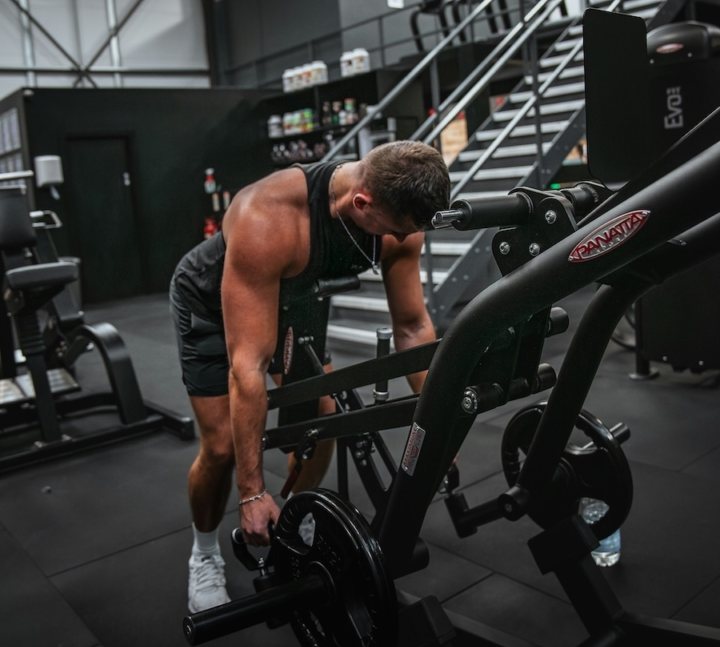Exercise
Lever Back Extension
How to Perform - Lever Back Extension
- Position yourself on the lever back extension machine with your hips resting on the pad, allowing your upper body to bend forward at the hips.
- Secure your feet under the ankle pads and place your hands either crossed over your chest or behind your head, maintaining a neutral spine position.
- Exhale as you slowly raise your torso by contracting your lower back muscles until your body forms a straight line parallel to the floor.
- Pause briefly at the top position, focusing on squeezing your glutes and lower back muscles for maximum engagement.
- Inhale as you slowly lower your upper body back to the starting position, maintaining control throughout the movement.
- Keep your neck in a neutral position aligned with your spine during the entire exercise, avoiding the tendency to look up or hyperextend.
- Engage your core muscles throughout the movement to stabilize your spine and prevent excessive arching in your lower back.
- Perform the exercise in a controlled manner, avoiding momentum or jerky movements that could compromise form and effectiveness.
Important information
- Never hyperextend beyond a flat back position to avoid placing excessive stress on your lower spine.
- Adjust the machine to properly align the pivot point with your hip joint before beginning the exercise.
- If you experience any lower back pain during the movement, reduce the range of motion or consult with a fitness professional.
- Focus on quality contractions rather than quantity, keeping tension in the target muscles throughout the entire set.
Primary Muscles
Muscle Groups
Mechanic
Risk Areas
Built for progress
Take the guesswork out of training
Create personalized AI-powered workout plans that evolve with you. Train smarter, track every rep and keep moving forward, one workout at a time.






The Lever Back Extension stands as a formidable ally in strengthening the posterior chain, particularly targeting the erector spinae muscles that run along your spine. This intermediate-level movement has earned its place in both serious bodybuilding regimens and rehabilitation protocols, offering significant benefits for spinal health and athletic performance.
What makes this exercise particularly valuable is its isolation of the lower back muscles without placing excessive compression on the spine. The controlled nature of the movement allows for intentional stimulation of the erector spinae group, which plays a crucial role in maintaining proper posture and spinal alignment during heavy compound lifts like deadlifts and squats.
For bodybuilders, the Lever Back Extension serves as more than just an aesthetic enhancer—it creates that coveted thickness and definition along the spinal column. The exercise allows for progressive overload by adding weight plates or resistance bands, making it adaptable to various strength levels and training goals. Many athletes incorporate this movement into their recovery protocols as well, using lighter loads to increase blood flow to the lower back region without overtaxing the central nervous system.
Strength athletes particularly appreciate how this exercise contributes to improved performance in powerlifting and Olympic lifting. By strengthening the erector spinae, you're essentially building a more robust natural weight belt, enhancing core stability and power transfer throughout the kinetic chain. This translates to greater force production in everything from deadlifts to clean and jerks.
While often overlooked in favor of more glamorous exercises, the Lever Back Extension deserves serious consideration in any comprehensive training program. Its ability to isolate and strengthen the crucial erector spinae muscles provides both preventative benefits against back injuries and performance enhancements across various athletic disciplines. Whether you're looking to sculpt a more defined back, recover from training stress, or build foundational strength, this movement delivers remarkable results when performed consistently and with proper technique.
FAQ - Lever Back Extension
The Lever Back Extension primarily targets the erector spinae muscles that run along your spine. It also engages your glutes, hamstrings, and the entire posterior chain as secondary movers, making it an excellent exercise for developing back thickness and spinal stability.
This exercise can actually be beneficial for many with lower back problems as it strengthens spinal erectors without excessive compression. However, start with bodyweight only, focus on controlled movement, and consult a healthcare provider if you have existing back conditions or pain during performance.
Begin with bodyweight until you master proper form, then add resistance by holding a weight plate against your chest. For advanced progression, use resistance bands, increase time under tension with slower tempos, or try single-leg variations to challenge stability and strength.
The three most critical errors are allowing the hips to sag (losing the pike position), shoulders rolling forward (compromising joint safety), and excessive body wobbling due to poor core bracing. Focus on maintaining a straight line from hands to hips, keeping shoulders packed away from ears, and engaging your core throughout the movement.
Most lifters benefit from performing this exercise 1-2 times weekly with 2-4 sets of 10-15 reps. Place it toward the end of workouts that include deadlifts or squats, or use it as rehabilitation with lighter loads on recovery days to increase blood flow to the spinal erectors.






